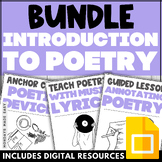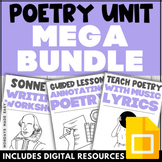Elements of Poetry Anchor Chart and Introduction to Poetry Slideshow Lesson
- Zip
- Google Apps™

What educators are saying
Also included in
- This high school poetry unit includes 190 pages of materials for reading poetry! Explore the elements of poetry, analyzing music lyrics, poetic devices, annotating poetry, and more. Suitable for distance learning and Google Classroom®.⚡️⚡️⚡️ Save 30% with the bundled discount! ⚡️⚡️⚡️Included in this bunPrice $17.50Original Price $26.40Save $8.90
- This modern high school poetry unit will hook even your most reluctant learners! This bundle provides over 300 pages of materials including slideshow lessons, vocabulary activities, poetry writing workshops, assignments, rubrics, and more. Suitable for distance learning and Google Classroom®!⚡️ SavePrice $31.00Original Price $44.30Save $13.30
Description
This introduction to poetry lesson is perfect for exploring the elements of poetry - teach the basic structure of poetry with the elements of poetry anchor chart and interactive slideshow provided with this resource. Includes digital worksheets for Google Classroom®!
Included with this Introduction to Poetry Lesson:
✏️ Introduction to Poetry Slideshow Lesson - Microsoft PowerPoint® and Google Slides®
- Explore the characteristics of poetry
- Scaffold how to read and interpret poetry
- Introduce the elements of poetry, including meter, verse, and stanza
✏️ Elements of Poetry Anchor Chart Activity - Digital & Print
✏️ Elements of Poetry Gallery Walk - Digital & Print
- Read and interpret 8 differentiated and diverse examples of classic poetry
- Includes editable gallery walk station template
✏️ Poetry Graphic Organizer for Gallery Walk - Digital & Print
- Prompt students to explore the structure, meaning, and personal response of each poem
- Includes differentiated graphic organizer for diverse learning profiles
✏️ Answer Keys for Consolidating These Activities - Ready-to-Print
✏️ Teacher Instructions for using this resource
How to use this Introduction to Poetry Lesson:
This lesson explores common poetic forms and solidifies students' understanding of the elements of poetry.
You can begin this lesson with the interactive Introduction to Poetry Slideshow. Students will be prompted to call forward their background knowledge of poetry from previous learning. They will also compare poetry to expository forms of writing to differentiate between the elements of poetry and other writing styles.
This slideshow will also introduce key terminology, including meter, verse, and stanza. Finally, this lesson will scaffold the process of reading and interpreting poetry using a provided poem.
Students will then complete the elements of poetry vocabulary activity, which will introduce 16 different poetic elements and forms. They will be prompted to find a formal definition for each poetic form and to paraphrase this definition to solidify their understanding. They will also be prompted to find an example to demonstrate each form.
The elements of poetry in this lesson include:
- Blank Verse
- Rhymed Verse
- Free Verse
- Stanza
- Meter
- Rhyme
- Scheme
- Narrative Poem
- Haiku
- Pastoral Poem
- Sonnet
- Lyric
- Ode
- Limerick
- Ballad
- Soliloquy
You can facilitate this activity independently or collaboratively. To assign it independently, you can provide each student with their own elements of poetry vocabulary workbook. As a collaborative activity, you can divide students into groups and have each group explore a single term. Then, have each group present their term to the class before adding their word to the bulletin board. Once you have completed this activity, you will have a useful elements of poetry anchor chart for your classroom.
This resource also includes an Elements of Poetry Gallery Walk. This activity includes 8 different stations. Each station features a classic poem for students to interpret. The poems range in level and feature diverse authors from the public domain; if there are select authors you would like to explore, a Blank Gallery Walk Template has also been provided.
Students can use the Poetry Graphic Organizer for each station of the gallery walk. This graphic organizer prompts students to consider the structure, meaning, and figurative language utilized within each poem. A differentiated graphic organizer has also been provided to accommodate diverse learning profiles.
Detailed answer keys have also been provided to consolidate these activities.
⭒ For classrooms utilizing Google Classroom® ⭒
To access the digital versions of these resources, simply follow the instructions within the resource to copy the files directly to your Google Drive®.
This resource is included in Mondays Made Easy's Introduction to Poetry Unit.
❤️ See what others are saying! ❤️
Kelly C.
October 7, 2022
⭐⭐⭐⭐⭐ Extremely satisfied
This is a great resource to help students learn or review poetry elements. It is very engaging and easy to use.
Travis G.
May 2, 2022
⭐⭐⭐⭐⭐ Extremely satisfied
A well-thought-out slideshow with worksheets that came in handy throughout our poetry unit. This was great.
Mrs Raders Novel Ideas (TPT Seller)
October 13, 2021
⭐⭐⭐⭐⭐ Extremely satisfied
My students were able to follow along and discuss what they knew about poetry! Great help for keeping students focused.
✨ Kindly note that due to copyright restrictions, this resource is not editable. This is a common practice within the TPT marketplace in order to protect the clip artists and software providers that have authorized their intellectual property for the development of this resource.
⭐ Customer Tip! ⭐
Want FREE CREDIT to go towards purchases? Make sure to offer feedback for your downloads! Follow these instructions below:
- Go to your "My Purchases" page to find a "Provide Feedback" button next to each download.
- Follow this link to offer a quick rating and leave a short comment for the product. Each time you give feedback, TPT gives you feedback credits that you use to lower the cost of your future purchases!
- Your feedback is important to me as it helps me to continually improve my products and ensure they are meeting your needs!
Follow me! Be the first to know about product launches, sales, discounts, and free giveaways:
➾ The Blog
For questions, collaborations, or other concerns:
✉ Contact me: hello@mondaysmadeeasy.com
Access my Free Resource Library!
Mondays Made Easy is committed to the continual improvement of resources to meet the current needs of teachers. This product was last updated on July 24, 2023.







